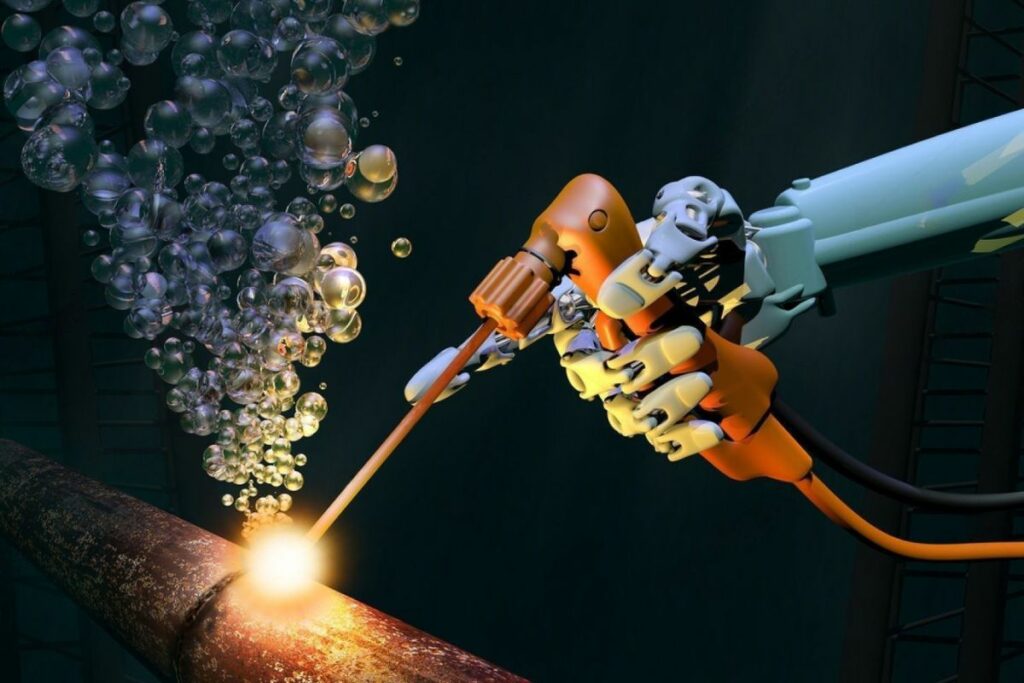
Not many are aware of the idea of underwater welding. Usually, people see the mixture of electricity and fluid as a bad idea or an incompatible combination. However, it is surprising to know that welding underwater is possible and has been done for some beneficial reasons like emergency repairs when salvage is required on ships or structures, or installation of new offshore drilling structures and harbor facilities.
This article discusses everything you need to know about underwater welding. It covers the basics of underwater welding, its categories, dangers or hazards, and types of methods.
Underwater welding was invented in the early 1930s by the Russian metallurgist Konstantin Krenov. To this day, it is still used to maintain and repair submerged marine structures, making underwater welding as relevant today as ever across the world. Also known as hyperbaric welding, this type of welding is performed while the welder is submerged usually at barometric pressures.
Underwater welding is not much different from welding on land. Both forms of welding utilise the same fundamental techniques and tools. Several people have the misconception that underwater welding is done literally on the water while submerged, thus becoming wet. However, it can take place not just in the water itself (wet welding) but also in a dry and pressurised enclosure (dry welding).
The two main categories of underwater welding techniques are wet underwater welding and dry underwater welding (also called Hyperbaric welding).
Wet welding entails the performance of welding directly in the water and usually involves a specially designed welding rod. Since this type of welding occurs in open water, the welder is exposed to the elements. Some have advised that wet welding must be a last resort since there is an obvious risk. Such risk includes the immediate cool down of the welded joint due to the surrounding water which could lead to joint defects. However, it also has advantages such as low cost and fast, access to weld spots, high tensile strength, and no need for construction.
Dry welding, on the other hand, consists of a hyperbaric chamber that is deployed to provide a dry environment. Unlike wet welding, dry welding is done in a dry atmosphere that composes of a mixture of gases. Moreover, welding is done at the prevailing pressure in a chamber. This chamber is filled with a gas mixture that is sealed around the structure being welded. Thus, welding in this category is similar to that carried out in open-air conditions. The difference, however, is that the fumes and gases caused by the welding affect the confined environment.
Welders encounter constant risks as welding is done in a dark place. The injuries that could happen are mostly long-term and can even result in death. Underwater welding exposes workers to numerous risks such as electric shocks, explosions, exposure to hazardous materials, or even drowning.
Shocks, explosions, and electrocution are huge threats to underwater welders. This is the reason why welders use waterproof tools or protective equipment. Hazardous materials like lead or the dangers of debris are present in this type of welding. Moreover, too much nitrogen in one’s blood would lead to decompression sickness. If there is improper equipment or inadequate tools, it would result in hypothermia because of extreme coldness. Drowning is also a possibility if there are unfortunate equipment failures underwater. Since it is challenging to escape, given the environment, it may trap the diver or welder.
Oil and gas companies utilise underwater welding to fix and restore pipelines and offshore platforms. Businesses involving shipyards and salvagers also use underwater welding to perform the removal process on sunken ships. Underwater welding is also easier in repairing and building shipyards. Industries relating to nuclear power plants also form a crew of underwater welders to repair reactors. Even military personnel make use of underwater welding to repair submarines and underwater devices. Repair companies also employ this type of welding in repairing cracks in dams and the like.
The risks of underwater welding are too significant to ignore but the field and cause are still well worth a try. Even with the potential dangers, the specialised skills and training make it all the more challenging and exciting. The rigorous standard required in this type of welding simply shows its value as a highly-specialised trade ideal for those up for a good challenge.